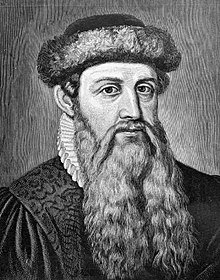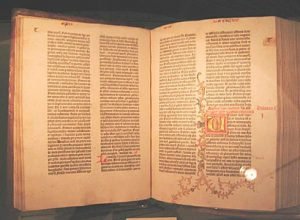Gutenberg: The inventor who changed the world

Johann Gutenberg (1399-1468), was born in Mainz, Germany. The father of Johann Gutenberg was a merchant and his mother the daughter of a shopkeeper. Its real last name is Genfleisch, whose translation of the German dialect of the Rhineland would be related to "goose meat", reason why the inventor of the modern printing press decided to use the surname Gutenberg. The advance took place in the fifteenth century, thus improving the printing of books on a large scale. Before the invention of the printing press, books and documents were produced by handwritten copies, most of the time by monks, resulting in a slow and arduous work. In the low average age in Europe woodcut was used, on a wooden board an artisan engraved the words or drawings that had to be reproduced. The work was very laborious and if some piece was worn or part of the content changed, the complete mold had to be repeated.
Gutenberg's merit was to perfect existing printing techniques, he fused each of the letters of the alphabet in metal separately, and devised a system to put them one after the other and hold them. In this way, the pages could be composed faster and the molds could be reused to compose others. To reproduce the drawings, the woodcut was still used and later they were painted by hand.
Before revolutionizing printing, Johann Gutenberg worked as a blacksmith in the bishopric of Mainz, since he knew the art of the most precious metal foundry: gold. This knowledge was very useful for the function of mobile types.
Surely Gutenberg studied at the University of Erfurt, whose name is registered as Johannes of Alta Villa (Eltvilla), in the year 1419, but it is only known that until 1434 he lived as a silversmith in Strasbourg where he subsequently formed a partnership with Hanz Riffe to develop what that is believed was the beginning of the printing press.
In Mainz he was associated with Johann Fust, who granted him a loan to develop his invention, fruit of which in 1449 the "Missal of Constance" was published, considered as the first printed book with movable types in the West. Some current studies question the date and even the authorship of this work, considering that it was printed later, even after the death of Gutenberg.

Replica of the Gutenberg press and mobile types.
In 1452 begins the printing of the most important work in the world of printing, the "Bible of 42 lines" or "Bible of Gutenberg", marking the beginning of the Age of Printing. In 1455 Gutenberg is about to finish the 150 Bibles committed, but Fust does not want to extend the term of the loan and ends up keeping the business rights. At the head of the printing press he put his nephew Peter Schöffer, who had worked as Gutenberg's apprentice and knew the secrets of the invention of the printing press.
Johann Gutenberg ended up staying in the ruin and being forced to reveal his invention to other printers.

Of the "Bible of 42 lines" (named for the number of lines printed on each page), 180 copies were produced (45 on parchment and 135 on paper), a large number of books printed at the time, receiving the name of incunabula , denomination received by all printed books before January 1, 1501.